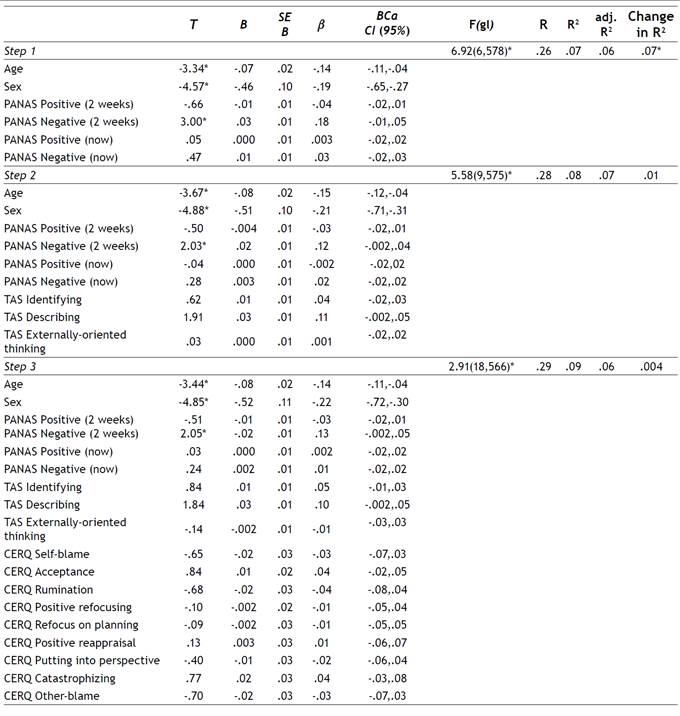Introduction
Gambling and gaming disorder have been established as behavioural addictions in the ICD-11 (WHO, 2018), while the DSM-5 acknowledges gambling disorder and recommends further research on internet gaming disorder (APA, 2013). Gambling and gaming disorder are increasing their prevalence among young people. For example, in Spain, an estimated 3.4% of adolescents exhibit problem gambling (OEDA, 2022), and in Italy 3.75% of adolescents (Bozzato et al., 2020), while a sample of Mexican university students found a prevalence of 14.6% (Chan-Gamboa et al., 2019). In the case of gambling disorder, the global prevalence may be 3.05% and it is suggested that prevalence tends to be higher in males and adolescents (Stevens et al., 2021). Likewise, multiple studies highlight the existence of comorbidity between both gambling and gaming disorders (Karlsson et al., 2019).
There are behavioural and psychological similarities between some forms of gambling and gaming, as both activities rely on variable reinforcement schemes that substantiate and prolong the activity, and on the use of attractive stimuli (McBride & Deverensky, 2016) additionally, the shared characteristics of both activities may be responsible for such comorbidity (Zendle & Cairns, 2019). Loot boxes may explain the co-occurrence of both behaviours, as real money is spent on them and they have in-game rewards, which has been directly linked with gaming disorder and gambling severity (Li et al., 2019). In addition, gaming is also more prevalent in young men (McBride & Deverensky, 2016).
Difficulties in emotional management have been found in people with gambling disorder (Mestre-Bach et al., 2020). Furthermore, alexithymia has been found to be related to increased difficulties in emotion regulation as emotion identification is a key process for emotion regulation (Preece et al., 2022).
Alexithymia can be considered a cognitive deficit in the ability to self-regulate emotions (Marchetti et al., 2019) and is characterised by a poor ability to analyse, describe, identify and differentiate one’s own and others’ emotional states (Brewer et al., 2016), being more common in young men (Bagby et al., 1994). Furthermore, it has been linked to neural correlates of reward processing in individuals with substance use disorders (Morie et al., 2017). It has been argued that individuals with alexithymia may react impulsively when faced with stressful situations (Corral & Barros, 2017) as they may use impulsive actions to cope with emotional arousal (Herman et al., 2020). In the case of gambling disorder, several studies have found a higher prevalence of alexithymia in individuals who are affected by it (Estévez et al., 2021). In the case of video games, some authors suggest that frequent users of video games may show higher levels of alexithymia (Gaetan et al., 2016).
In turn, emotion regulation refers to the process by which individuals influence what emotions they feel, when they feel them, and how they experience and express those emotions (Gross, 1998). No gender and age differences are found in emotion regulation (Guzmán et al., 2014). It has been shown that individuals experiencing gambling disorder in clinical samples had greater emotion regulation difficulties (Jauregui et al., 2016) and that gamblers with problematic videogame use tended to use videogames as a maladaptive coping strategy to deal with adverse emotional experiences and to escape from them (Di Blasi et al., 2019). Alexithymia and emotion regulation difficulties have been found to predict gambling disorder, and individuals with higher scores on alexithymia may have a greater tendency to exhibit addictive behaviours through emotion dysregulation processes (Elmas et al., 2017).
Nevertheless, there is no consensus in the literature about the relationship between gambling disorder and gaming disorder. On one hand, some studies highlight that there is an association between gambling problems and the frequent use of videogames (Delfabbro & King, 2020), and an overlap on the participation of young people in gambling and videogame activities (McBride & Deverensky, 2016). Additionally, previous research on loot boxes shows an important relationship between the amount of money spent on them and gambling severity (Li et al., 2019). On the other hand, other studies assert that videogames do not act as a pathway for developing gambling problems (Macey & Hamari, 2018) and that the involvement in one of these behaviours does not predict an excessive behaviour in the other (Sanders & Williams, 2018).
Even though previous research agrees on the importance of negative affect, alexithymia, and emotion regulation as risk factors for both gaming and gambling disorders, few studies have actually compared them with respect to these variables. Therefore, the aim of this study was threefold. First, to analyse the differences in gambling severity, videogame abuse, alexithymia, emotion regulation, and positive and negative affect as a function of the presence or absence of gambling and gaming disorder. Second, to assess the relationship between these variables, and third, to evaluate the predictive role of alexithymia and emotion regulation on gambling and gaming disorders.
Method
Participants
A sample of 1,219 adolescents and young adults aged 12 to 20 (M = 15.55, SD = 2.07; 52.3% females) was recruited. Further information on the sample has been included on Table 1.
Instruments
Gambling disorder. South Oaks Gambling-Revised Adolescents (SOGS-RA; Winters et al., 1993). Adapted to Spanish by Becoña (1997). The version for adolescents was validated by Lesieur and Blume (1987). This instrument comprises 12 items that have dichotomous responses (i.e., “yes” or “no”). Item 1 has four possible answers. Interpretation of SOGS-RA is as follows: 0-3, non-problem gambling; and 4 or more, problem gambling. This measure offers adequate psychometric properties (Cronbach’s alpha = .80). For the present study, Cronbach’s a coefficient was .87.
Gaming disorder. MULTICAGE CAD-4 (Pedrero-Pérez et al., 2007). The scale has 32 items and eight subscales. For the present study, only the subscale of gaming disorder was used, which covers items 21 to 24 and asks respondents about self-perception of the problem, perception by those around, feelings of guilt, and withdrawal and impulse control symptoms. The instrument is self-administered and items are rated on a yes-or-no scale. Scores are assessed as follows: 0-1 (no gaming disorder), 2 (risk of having gaming disorder), 3 (likely to have gaming disorder), and 4 (gaming di-sorder). Internal consistency in the original instrument was satisfactory (Cronbach’s a = 0.86 for the overall instrument, and 0.78 for the gaming subscale). For this study, Cronbach’s a for gaming was .76.
Positive and negative mood. Positive and Negative Affect Schedule (PANAS; Watson et al., 1988). Adapted to Spanish by Sandín et al. (1999). The instrument comprises 20 words that describe feelings and emotions corresponding to two categories: positive affect and negative affect, each comprising 10 items. The scores are rated on a 5-point Likert scale, ranging from 1 to 5. Respondents are required to report whether they are experiencing now or have experienced in the last two weeks. The internal consistency is high in both subscales, with a = .89 for men and a = .87 for women in positive affect, and a = .91 for men and a = .89 for women in negative affect. For the present study, Cronbach’s alpha was .85 for the last two weeks and .87 for now.
Alexithymia. Toronto Alexithymia Scale-20 (TAS-20; Bagby et al., 1994). Adapted to Spanish by Martínez-Sánchez (1996). Alexithymia is a 20-item, three-factor solution: (1) difficulty identifying feelings, (2) difficulty describing feelings, (3) externally-oriented thinking. Responses are scored on a 5-point Likert (0 = “Strongly disagree”, 5 = “Strongly agree”). Internal consistency is very good for the overall scale (a = .78 for the original, .82 for men and .76 for women). In the current study, Cronbach’s a was .76.
Emotion Regulation. Cognitive Emotion Regulation Questionnaire (CERQ; Garnefski & Kraaij, 2006). An 18- item version validated to Spanish by Domínguez-Lara and Merino-Soto (2017). The instrument measures the cognitive strategies a person uses in order to regulate their emotions in response to a stressful event. It is a self-report measure with a 5-point Likert scale and comprises nine subscales: self-blame, rumination, catastrophizing, other-blame, putting into perspective, acceptance, positive refocusing, positive reappraisal, and refocus on planning. There is evidence to support that the 18-item version and a previous, 36-item version are linearly equivalent. The reliability of the instrument is acceptable (a > .70), and for the present study was higher than the original (a = .87).
Procedure
A total of 546 schools and vocational schools were invited to participate, and 19 schools in urban areas responded. The survey was presented and explained by professional experts in the field who explained the procedure. Participants were given paper and pencil questionnaires or a link to access the survey online (via a Google Form). All partic ipants signed a consent form, including parents in the case of minors who participated in the study. Anonymity, confidentiality and the voluntary nature of the study were guaranteed. Data collection took place during 2018. The contact details of the research team were provided. Participants did not receive any compensation. The study received ethical approval from the Ethics Committee of the University of Deusto.
Data analysis
First, mean differences were calculated between different subgroups based on gambling and gaming disorder scores, emotion regulation, alexithymia, and positive and negative affect. A t-test was conducted between gamblers and non-gamblers. An ANOVA test was conducted among gaming disorder risk profiles: non-gaming disorder, at risk of ga-ming disorder, likely to have gaming disorder, and gaming disorder. A post-hoc Scheffe test was also carried out. A Kruskal-Wallis test was conducted based on the absence or presence of a gambling or gaming disorder, the simultaneous presence of both gambling and gaming disorders, or the absence of both. The effect size was analysed by means of Cohen’s d in the case of the t-test, and by eta square in the case of ANOVA and Kruskal Wallis.
Second, the relationship between the variables of the study was analysed through a Pearson’s r.
Third, hierarchical regression analyses were conducted to test the predictive role of alexithymia and emotion regulation in gambling and gaming disorder analysing the effect of age, sex, and positive and negative affect. Two models were tested (one of them for gambling disorder, and the other one for gaming disorder). In a first step, age, sex, and positive and negative affect were introduced; in a second step, these variables were introduced together with alexithymia; and in a third step, all the variables were introduced (age, sex, positive and negative affect, alexithymia, and emotion regulation). A bootstrapping procedure of 2,000 bootstraps was conducted.
Results
Mean differences in gambling and gaming disorder, alexithymia, emotion regulation, and positive and negative affect were calculated between the different groups. First, differences were calculated between participants with and without gambling problems (Table 2), finding significant differences in gambling severity, gaming disorder, alexithymia (identifying), emotion regulation (positive reappraisal and blaming others) and in affects (negative now and last two weeks and positive two weeks ago). The effect size was large for gaming disorder, medium for alexithymia - identifying, and small for the remainder of variables that had statistically significant differences.
Table 2 Mean differences between gamblers and non-gamblers in gambling disorder, gaming disorder, alexithymia, emotion regulation, and positive and negative affect
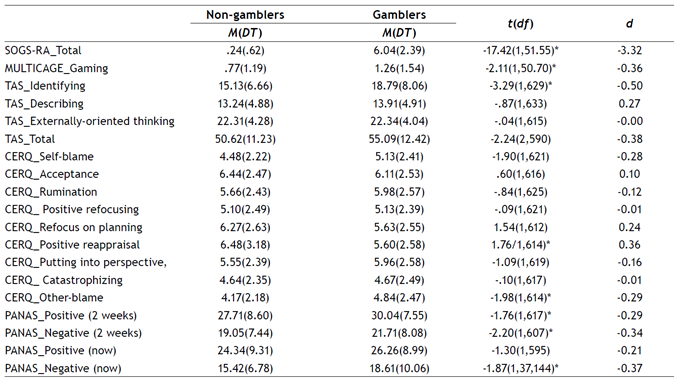
* = p < .05
Additionally, mean differences were calculated between gaming disorder profiles (Table 3). Significant differences were found in alexithymia (identifying, describing, and total scale), emotion regulation (catastrophizing), negative affect, gambling disorder, and gaming disorder. The effect size was large for gaming disorder, and small for gambling disorder, alexithymia, emotion regulation, and positive and negative affect (now and two weeks).
Table 3 ANOVA of gamers based on their gaming severity and alexithymia, emotion regulation, positive and negative affect, gambling, and gaming disorder
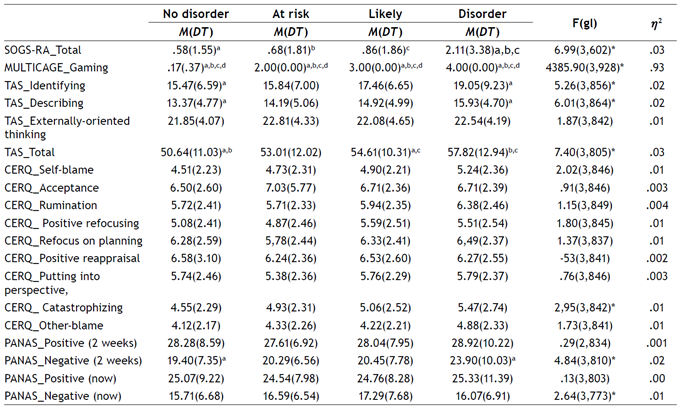
Notes. The four groups correspond to (1) no gaming disorder, (2) gamers at risk of having gaming disorder, (3) gamers likely to have gaming disorder, (4) gaming disorder.
* = p < .05, ** = p < .01
Third, the differences between participants based on presenting risk of having gaming disorder, gambling disorder, both, or neither of them were calculated (Table 4). There were significant differences in alexithymia (identifying, describing, and total), negative affect (two weeks), and gambling and gaming disorder. The effect size was small for alexithymia, emotion regulation, and positive and negative affect (now and two weeks), and large for gambling and gaming disorder.
Table 4 Mean differences between presence/absence of gambling and/or gaming disorder and gambling disorder, gaming disorder, alexithymia, emotion regulation, and positive and negative affect
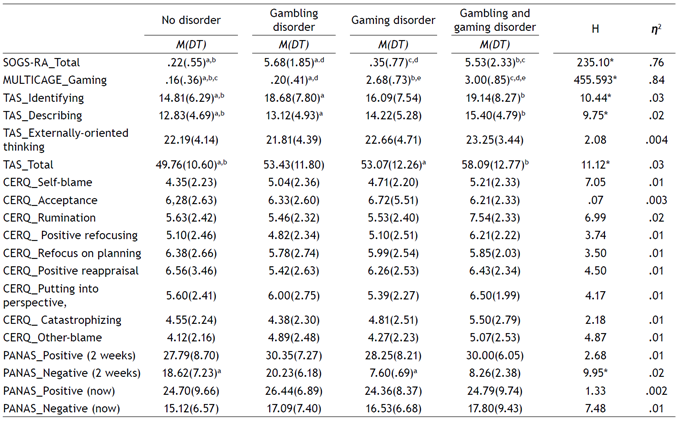
* = p < .05, ** = p < .01
Furthermore, correlation analyses were conducted between gaming, gambling, age, positive and negative affect, alexithymia, and emotion regulation (Table 5). Gambling disorder positively correlated with gaming disorder, negative affect, alexithymia (identifying and total), emotion regulation (self-blame and blaming others) and age. Gaming disorder positively correlated with gambling disorder, negative affect, alexithymia, and emotion regulation (self-blame and catastrophizing).
Table 5 Correlations between gambling, gaming, age, positive and negative affect, alexithymia, and emotion regulation
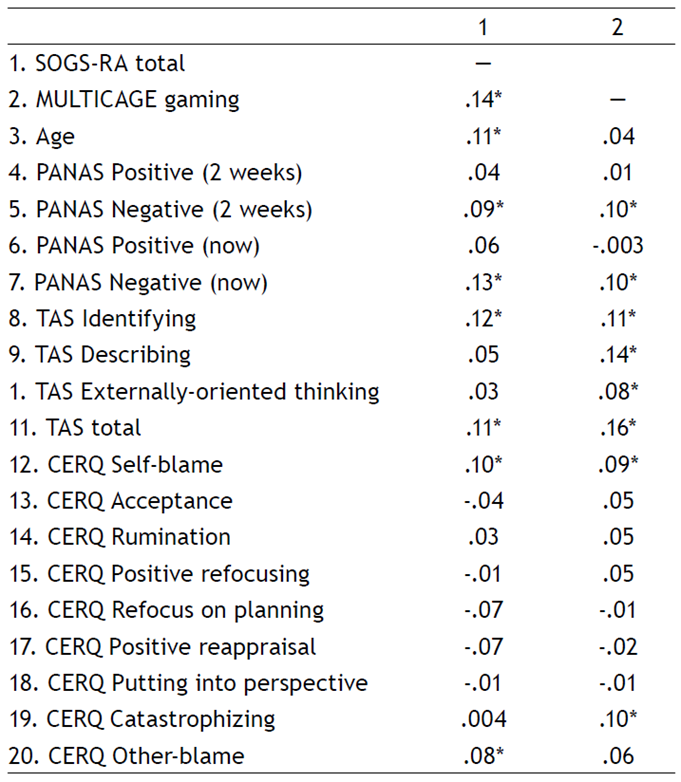
* = p < .05
Finally, hierarchical regression analyses were conducted to assess the predictive role of alexithymia and emotion regulation in gambling and gaming disorder (Tables 6 and 7). In the case of gambling, the main predictors were identifying emotions and catastrophizing, with a significant effect of age and negative affect (now). Regarding gaming disorder, analyses showed that age, sex, and negative affect (two weeks) were the main predictors in the final model. However, bootstrapping analyses with 2,000 samples showed that age, alexithymia (identifying) and negative affect (now) were the main predictors of gambling disorder, whereas age and sex were the main predictors of gaming disorder.
Table 6 Regression analysis of alexithymia and emotion regulation as predictors of gambling disorder analysing sex, age, and positive and negative affect
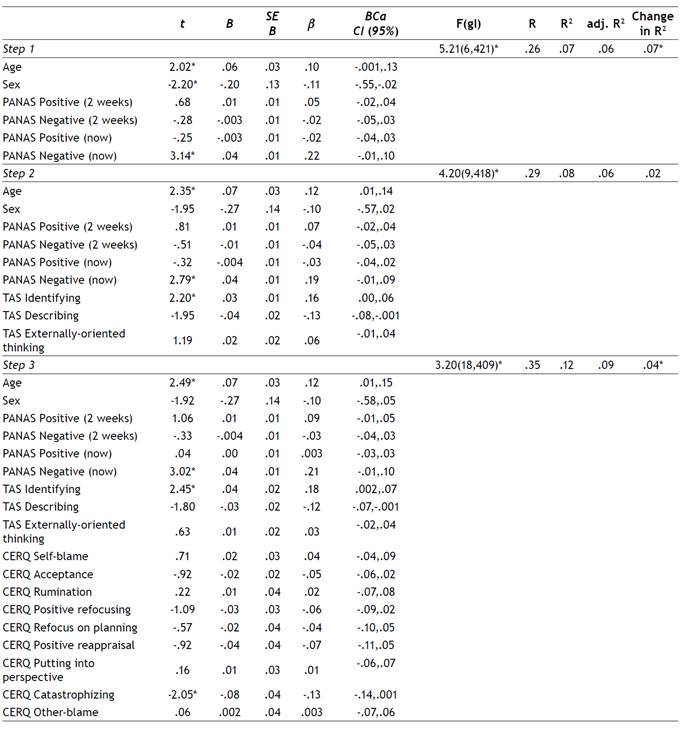
* = p < .05
Discussion
The present study sought to examine the differences in gambling, gaming, emotion regulation, alexithymia, positive and negative affect, as determined by the presence/ absence of gambling and gaming problems. The results showed that mean scores differences for gamblers versus non-gamblers were statistically significant in alexithymia, emotion regulation and gambling and gaming disorder. These results are in line with other studies that reported that individuals with gambling disorder showed a higher prevalence of alexithymia (Mestre-Bach et al., 2020), greater levels of gaming disorder (Delfabbro & King, 2020), and it has been found that a limited set of emotion regulation strategies predict gambling disorder (Di Blasi et al., 2019).
Similarly, mean differences between gamers were statistically significant in alexithymia, emotion regulation, negative affect, gambling disorder, and gaming disorder. Furthermore, the differences between those who had gambling or gaming problems, both, or neither, were also statistically significant in alexithymia, emotion regulation, negative affect, gambling disorder and gaming disorder severity. Such results are similar to those reported in other studies where it was found that alexithymia was higher among frequent gamers and those experiencing problem gambling (Gaetan et al., 2016).
The current study also examined the relationship between the variables of the study. The results suggested that there is a correlation between gambling and gaming disorder scores, something that has been previously noted (Karlsson et al., 2019). Other studies, however, disagree with such association and provide data to the contrary to argue that the excessive consumption of gaming or gambling products is not mutually predictive (Sanders & Williams, 2018).
With respect to age, the current study found that age was positively associated with gambling problems, but was not associated with gaming problems, meaning that individuals experiencing gambling disorder tend to be older than those experiencing gaming disorder. These results are in contradiction with those of Sancho et al. (2019), who found greater gambling severity in younger patients. The disagreement between both studies could be explained by the sample characteristics, given theirs was recruited from a clinical sample, whereas ours is population-based.
A statistically significant relationship was found between gambling and gaming disorder, and alexithymia, emotion regulation, and positive and negative affect. Many of the studies mentioned above also identified such a pattern (Di Blasi et al., 2019; Gaetan et al., 2016). In the case of gambling, its relationship with negative affect, alexithymia total, and with some dimensions of emotion regulation such as self and other-blame was significant. These are relevant results because blame has been found to be directly related to the severity of gambling (Estévez et al., 2022). In the case of gaming, a correlation was found in the present study with negative affect, alexithymia, and some dimensions of emotion regulation such as self-blame and catastrophizing. Again, such results further demonstrate the central role of emotion regulation and alexithymia.
The current study also aimed at identifying the emotional factors predicting gambling and gaming disorder. For gambling disorder, age was identified as a determinant, which replicates observations by Chóliz et al. (2019), as well as negative moods, which have also been shown to be predictors of gambling in other studies (Jauregui et al., 2020). Another determinant was the identification of emotions, in line with the theory linking alexithymia and gambling (Marchetti et al., 2019).
As to the predictors of gaming disorder, age and sex have been identified in the present study, in line with previous literature (Lau et al., 2018). The results did not align with available evidence suggesting the predictive role of alexithymia and emotion regulation in gaming disorder (Di Blasi et al., 2019; Gaetan et al., 2016), and also differ from the predictors identified in the present study for gambling disorder. A possible explanation could be the age difference between the participants engaging in gaming and gambling behaviours. According to Blanchard-Fields et al. (2004), older adults engage in passive emotion regulation strategies more often, while younger adults prefer to resort to active regulation strategies. Coincidentally, other research suggests emotion regulation deficits are higher among older rather than younger men (Sancho et al., 2019). Consequently, younger males could show more adaptive responses to their emotional problems associated with gaming in contrast to the more maladaptive responses to gambling problems of older adults.
This study comes with a series of limitations. First, the recruitment method of participants made the resulting sample non-representative, and thus, the results cannot be generalised to the entire population. Second, the study was conducted on adolescents and young adults, and its results might not be generalisable to older adults or clinical samples. Third, this is a cross-sectional study and the results obtained from correlations and regressions analyses cannot be used to determine causality. Fourth, being a self-report study means factors such as social desirability and recall bias could have influenced the responses of the participants. Fifth, the TAS may provide biased information on adolescents, since it has been validated in Finnish adolescents replicating the three-factor model, but there is a decline in the quality of self-report assessment for younger respondents (Bagby et al., 2020). Sixth, the percentage of the sample which reports gambling or gaming problems is low, so future studies should expand the number of participants at risk of presenting a problem. This could enable the comparison of results by age, for example, among early and late adolescents, which would be of great interest for future studies.
In understanding the relationship between gambling and gaming disorders, more studies are needed to explore the role of the structural elements that connect the two activities, such as loot boxes. If the use of loot boxes were a determinant for gaming disorder, they could theoretically lead individuals to gambling disorder as well, and in general, excessive gaming becomes a gateway for gambling disorder. In such studies, controlling for age would be crucial. It would also be interesting to replicate the study with a clinical sample and include qualitative results to have a better understanding of these issues.
In conclusion, the present study has identified a number of relationships between gambling and gaming disorder. Age and inability to identify and describe emotions have been found to predict gambling problems. In turn, age and sex were the main predictors of gaming disorder. Considering these sets of characteristics would be essential in order to plan effective psychological interventions. The results also highlight the importance of working with patients on their negative affect as a way of improving the prognosis of a number of behavioural addictions (Cuzen & Stein, 2014). For gambling disorder patients in particular, the results support the notion that psychological interventions must focus on developing emotion identification. Very importantly, as alexithymia has been found to improve after a clinical intervention (Marchetti et al., 2019), assessing alexithymia in early stages could have a beneficial impact for those individuals experiencing it and submitting to treatment1 2 3 .















